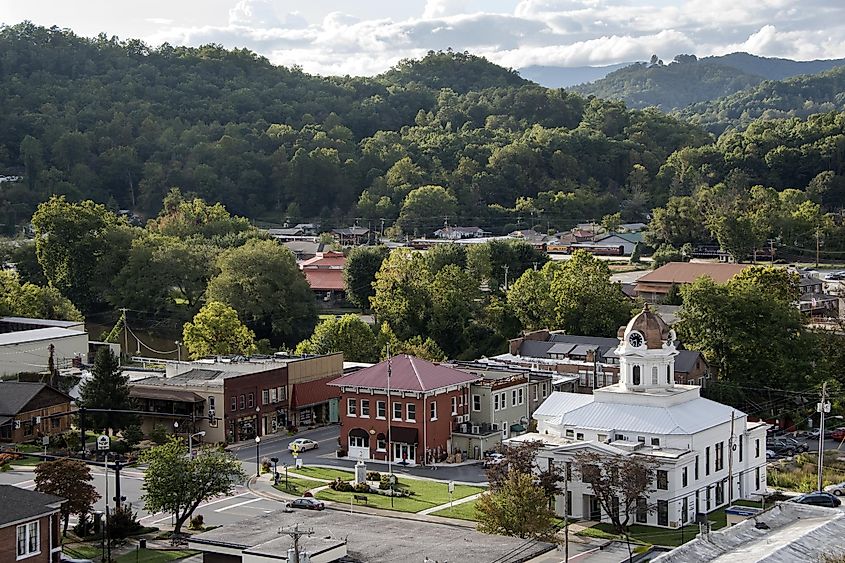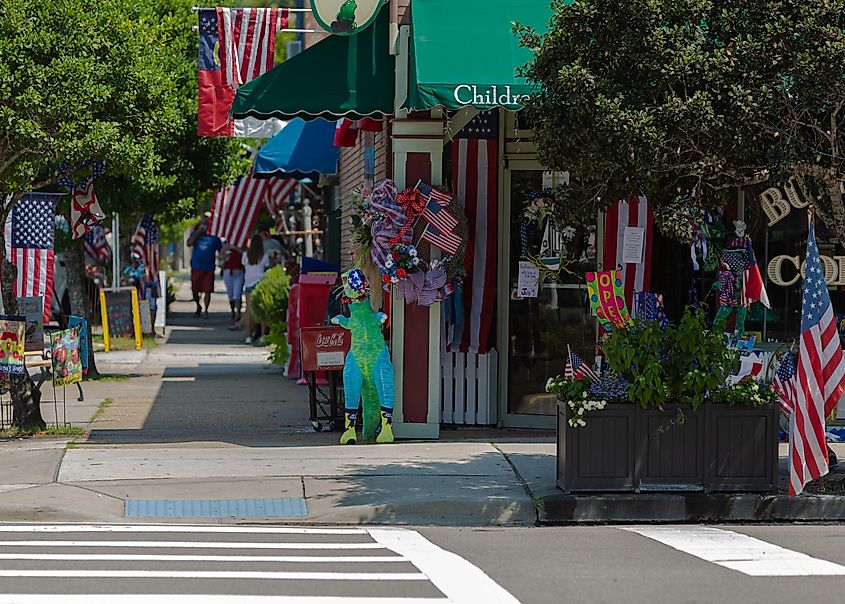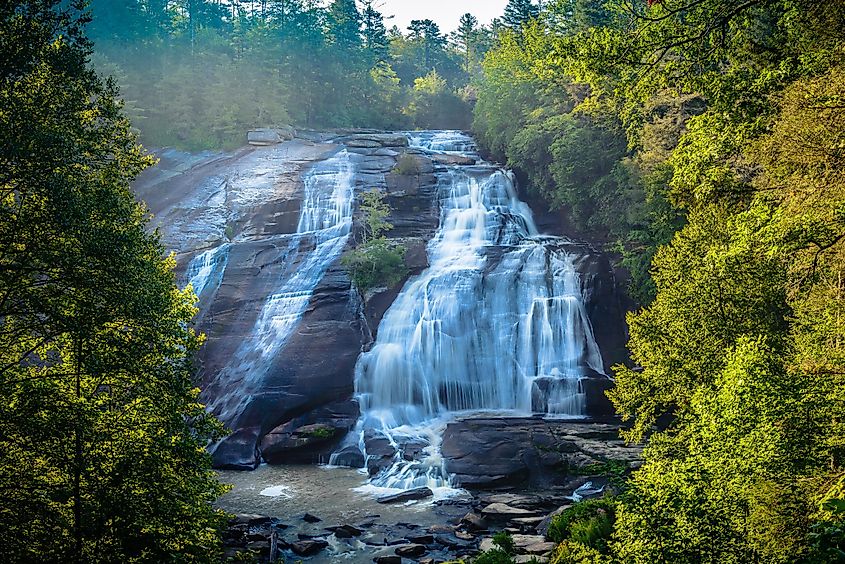
8 Coolest North Carolina Towns For A Summer Vacation In 2025
Think of July in the South as a sly adversary: barometric pressure rising, cicadas droning, sunscreen dripping faster than you can swipe your phone. Now imagine drafting a getaway map that steals back the season, one cool micro-climate at a time.
In 2025, North Carolina offers eight improbable refuges, where every town has engineered its own loophole in the laws of Carolina heat, by elevation, sea breeze, or sheer historical eccentricity.
Expect concert halls hiding inside forest clearings, ferry rides to islands where horses outnumber humans, and culinary stops where river trout or she-crab soup land on the plate before the condensation forms on your glass. Pick one refuge or stitch all eight into a road-trip caper; either way, you’ll finish the summer wondering how the rest of the Carolinas missed the escape hatch.
Highlands

Highlands sits at 4,118 feet on the Eastern Continental Divide, making it one of the highest incorporated towns east of the Mississippi. As a result, summer temperatures rarely rise above the high 70s. It also receives more than 80 inches of rain annually, creating dense temperate rainforests and sustaining multiple waterfalls within walking distance of the town center. The town's isolation, accessible primarily by winding two-lane roads, has contributed to a highly curated mix of cultural and natural assets with few concessions to mass tourism.

The Bascom, a visual arts center, is a must-visit and is set in a converted barn that offers rotating exhibitions, studio workshops, and a sculpture trail. Hike the Whiteside Mountain Trail, a 2-mile loop that crosses some of the oldest exposed rock in North America and offers 700-foot cliff views. For dining, Wild Thyme Gourmet serves regional trout and local produce inside a restored Main Street storefront. The Highlands Biological Station, operated by Western Carolina University, includes a botanical garden, research lab, and educational programming focused on native Southern Appalachian ecosystems.
Bryson City

Bryson City is one of the few towns in the United States bordered by a national park, a national forest, and a designated Wild and Scenic River! Its location at the southern edge of Great Smoky Mountains National Park has made it a base for both tourism and conservation since the park’s founding. The town is also home to the North Carolina half of the 72-mile Appalachian Trail segment that crosses Clingmans Dome, the park’s highest point.

Start with the Great Smoky Mountains Railroad, which operates heritage diesel and steam excursions from the town depot, including the seasonal "Raft & Rail" trip that pairs a train ride with a Nantahala River rafting experience. For hiking and tubing, enter the Deep Creek area of the national park, three miles from downtown, which includes access to Tom Branch, Indian Creek, and Juney Whank Falls. Eat at The High Test Deli & Sweet Shop, known for hot sandwiches and house-made lemon bars. Visit the Swain County Heritage Museum, located in the restored 1908 courthouse, which offers exhibits on logging railroads, Cherokee history, and early tourism.
Beaufort

Beaufort is North Carolina’s third-oldest town, chartered in 1722, and one of the few in the U.S. with a cemetery older than its statehood. The Old Burying Ground, established in the early 1700s, includes graves of Revolutionary War soldiers, British naval officers, and victims of yellow fever epidemics. Beaufort also played a role in pirate history, Blackbeard’s ship, Queen Anne’s Revenge, ran aground nearby in 1718, and artifacts recovered from the wreck are housed in town.

To explore the maritime history, visit the North Carolina Maritime Museum, which maintains permanent exhibits on shipwrecks, coastal ecology, and Blackbeard’s vessel. Take the Island Express Ferry from the waterfront to Shackleford Banks, part of Cape Lookout National Seashore, where visitors can encounter wild horses and collect unbroken whelk shells. For lunch, Clawson’s 1905 Restaurant & Pub serves seafood platters in a restored general store. Walk through Rachel Carson Reserve, accessible by kayak or small boat, which contains estuarine trails and supports over 200 bird species.
Boone

Boone sits at over 3,300 feet and maintains average July highs in the low 70s, making it one of the coolest climate zones in the southeastern United States. It is also home to Appalachian State University, whose presence has led to long-term support for the arts, environmental research, and low-impact tourism. The town’s name honors Daniel Boone, who reportedly camped here in the 1760s, and local trails still intersect with portions of the route he traveled.
Start with the Appalachian Summer Festival, which runs through July and features ticketed events in music, dance, and visual arts, headquartered at the university’s Schaefer Center. Hike Moses H. Cone Memorial Park, located off the Blue Ridge Parkway, where carriage trails pass through preserved meadows and white pine groves. For breakfast, Melanie’s Food Fantasy serves sourdough pancakes and local eggs on King Street, with seating often filled by university faculty and staff. Visit Hickory Ridge Living History Museum, a cluster of 18th-century cabins adjacent to the Daniel Boone Amphitheater, where costumed interpreters demonstrate traditional blacksmithing, weaving, and cider pressing.
Blowing Rock

Blowing Rock is named for a geological formation where wind currents from the Johns River Gorge blow vertically, often forcing light objects thrown from the rock to return upward. At 3,500 feet, the town sits on the Eastern Continental Divide and claims one of the most stable summer climates in the state. The Blowing Rock itself, privately managed since 1933, remains a central viewpoint and includes access to landscaped trails and an observation tower.

Art in the Park, a juried outdoor show series running one Saturday per month from May through October, lines Park Avenue with work by regional painters, potters, and metalsmiths. The Blowing Rock Art & History Museum (BRAHM) offers exhibitions on Appalachian textiles, Cherokee crafts, and southern portraiture. For hiking, the Glen Burney Trail, accessible from downtown, descends 800 feet into a gorge past three waterfalls, including Glen Marie Falls. Eat at The Speckled Trout, which serves rainbow trout and seasonal vegetables with house-made preserves and local ciders.
Southport

Southport is one of the only towns on the North Carolina coast where the Cape Fear River, Intracoastal Waterway, and Atlantic Ocean converge. Originally named Smithville, it rebranded in the 19th century to attract port investment, which never materialized, leaving behind a preserved grid of maritime cottages and wharves without large-scale development. Southport has been a filming location for over 40 productions, including I Know What You Did Last Summer and Safe Haven, and uses that legacy to support walking tours and tourism infrastructure rooted in its architectural continuity.

Your first stop should be the North Carolina Fourth of July Festival, a multi-day event that includes a veteran’s parade, a naturalization ceremony, fireworks over the river, and a shrimp-and-grits cookoff. Visit Fort Johnston-Southport Museum & Visitors Center, housed in an 18th-century garrison that was active through World War II. For seafood, eat at Fishy Fishy Café, located on Yacht Basin Drive, which sources clams and oysters from nearby Lockwoods Folly River. Walk or cycle to Waterfront Park, where bench plaques mark family histories and ships from the Military Ocean Terminal Sunny Point pass by on the Cape Fear.
Nags Head

Nags Head is the only Outer Banks town where preserved maritime forest, active dune fields, and submerged shipwrecks exist within municipal boundaries. It is also adjacent to a section of the Graveyard of the Atlantic, where thousands of vessels have wrecked due to shifting sandbars and storm activity. The town’s name likely originated from local decoy lantern schemes used to lure ships ashore for salvage, an early, informal coastal economy. Today, Nags Head anchors a portion of the Outer Banks National Scenic Byway and maintains public access to both ocean and sound.
At Jockey’s Ridge State Park, discover the tallest active sand dune system on the East Coast. Explore the Nags Head Woods Ecological Preserve, a 1,400-acre maritime forest managed by The Nature Conservancy, where boardwalks cross interdunal wetlands and relic dune fields. Eat at Tale of the Whale, a waterfront restaurant on the causeway serving she-crab soup and broiled seafood platters. For shipwreck observation, kayak from Soundside Park across Roanoke Sound to view remnants of the USS Huron or other nearshore wrecks visible at low tide.
Brevard

Brevard is one of the few places in the world where white squirrels roam free. Introduced decades ago, possibly escaped carnival animals, these rare creatures now have protected status, monitored by the city and celebrated with an annual count. Their presence sets the tone for a town defined by unusual details and deliberate preservation. Located at the edge of Pisgah National Forest and surrounded by the Blue Ridge escarpment, Brevard is a practical summer base for travelers drawn to elevation, waterfalls, and Appalachian culture.

Visitors can tour the Brevard Music Center, a 180-acre campus hosting more than 80 public concerts each summer, ranging from orchestral works to contemporary ensembles. A short drive leads to Looking Glass Falls, a roadside cascade where visitors can wade directly into the plunge pool. In town, Highland Books is an independent bookstore known for its deep regional history section and curated new releases. For lunch or coffee, Velvet Cup Coffee Truck, parked near Brevard College, serves cold brew and biscuit sandwiches using locally sourced ingredients.
From mountain ridgelines to salt-spray estuaries, these eight towns give North Carolina its summer escape clause. Each location scales tourism down to human speed, concert halls tucked behind hemlocks, oyster decks above tidal creeks, heritage rails threading river gorges, while the thermometer stays mercifully restrained. Chart one waypoint or link the entire circuit; either way, 2025 travel becomes cooler, quieter, and sharply focused on place rather than crowds, heat, humidity, and haste.











